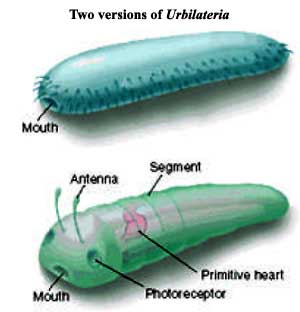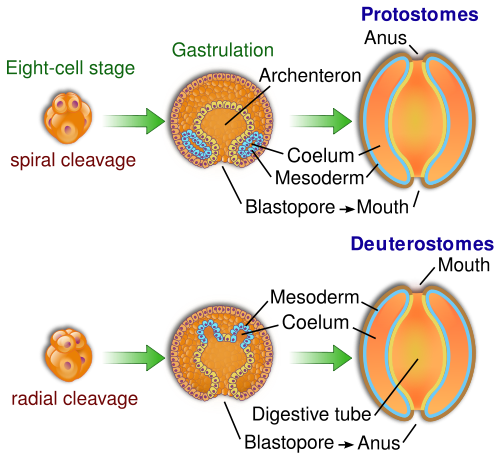Bilateria
Animals with Bilateral Symmetry
 This category includes all Metazoa with bilateral symmetry (having a definite front and rear, and left and right body surfaces), either in their adult stage or (in the case of types with secondary radial symmetry, such as echinoderms) in the larval stage. Many bilaterian animals exhibit cephalization, which is the evolutionary trend toward concentration of sensory structures, mouth, and nerve ganglia, at the anterior end of the body. This body type is related to the further elaboration of hox genes
This category includes all Metazoa with bilateral symmetry (having a definite front and rear, and left and right body surfaces), either in their adult stage or (in the case of types with secondary radial symmetry, such as echinoderms) in the larval stage. Many bilaterian animals exhibit cephalization, which is the evolutionary trend toward concentration of sensory structures, mouth, and nerve ganglia, at the anterior end of the body. This body type is related to the further elaboration of hox genes
All bilaterians are triploblastic, which means they develop three germ layers during embryonic development. The three germ layers are
- Ectoderm - Covers the surface of the embryo and forms the outer covering of the animal and the central nervous system in some phyla.
- Endoderm - the innermost germ layer which lines the archenteron (primitive gut). It forms lining of the digestive tract and out-pocketing give rise to the liver and lungs of vertebrates.
- Mesoderm - located between the ectoderm and endoderm. Forms the muscles and most organs located between the digestive tract and outer covering of the animal. The circulatory and (in vertebrates) the skeletal system stems from this
Note that only Bilateria have a mesoderm.
Bilateria is defined by reference to a hypothetical organism, Urbilateria, who was the last common ancestor of Deuterostomia (echinoderms and the various chordate phyla) and Protostomia (all other "higher" animals). Classically, these two groups were said to differ in a number of respects. Some of these characteristics have been challenged recently, but they remain generally true:
|
Update (April 2007): A number of papers published in the last few years have made it clear that the whole traditional concept of Bilateria is probably mistaken. Bilateria supposedly have three unique features: (1) bilateral symmetry, (2) hox gene patterning of the anteroposterior axis, and (3) mesoderm. It turns out that developing cnidarians clearly have (1), probably have (2), and may even have (3). It seems even more likely now that the Cnidaria are paraphyletic. That is, all of us bilaterian animals are just jellyfish who happened to use a particular type bilateral symmetry and used the hom genes in a particular way.
This may have important phylogenetic implications. We cannot assume that any bilateral organism with a couple of the usual hom genes is inside the crown group of Bilateria. Consequently, the predictions we made last year (see end of this essay) about Metazoan phylogeny are looking good.
Most of this is covered in Brooke & Holland (2003), which we cited -- but obviously didn't pay enough attention to. To see how far things have progressed at this point, see Ryan et al. (2007). ATW070404 |
One important difference involves the cleavage patterns; the division of cells in the early embryo. Protostomes are characterized by a spiral (the planes of cell division are diagonal to the vertical axis of the embryo) and determinant (the goal of each embryonic cell is established very early) cleavage. Deuterostomes undergo radial parallel or perpendicular to the vertical axis of the embryo) and indeterminate cleavage (each early embryonic cell retains the capacity to develop into a complete embryo if isolated from other cells). But see, Halanych 2004); Hejnol & Schnabel (2004).
There is a strange symmetry in the fate of the blastopore (the first opening of the archenteron which forms during gastrulation.). In Protostomes ("mouth first") the blastopore forms the mouth; in Deuterostomes ("mouth second") - blastopore forms the anus. (see following diagram) .
Another difference involves how the mesoderm surrounds the body cavity. It can either pouch off or split entirely. In Schizocoela or Protostomia, it splits. In the Enterocoela or Deuterostomia, the mesoderm (or archenteron, the original gut) pouches off
 This diagram is showing the difference of the two major types of coelomates: the protostomes (molluscs, annelids, arthropods, ...) and deuterostomes (echinoderms, vertebrates, ...). These groups differ in several characteristics of early development; In deuterostomes blastula devisions is called "radial cleavage" because it occurs parallel or perpendicular to the major polar axis. In protostomes the cleavage is called "spirale" because division planes are oriented obliquely to the polar major axis. During gastrulation, protostomes embryos' mouth was given first by the blastopore while the anus was formed later and vis versa for the deuterostomes
This diagram is showing the difference of the two major types of coelomates: the protostomes (molluscs, annelids, arthropods, ...) and deuterostomes (echinoderms, vertebrates, ...). These groups differ in several characteristics of early development; In deuterostomes blastula devisions is called "radial cleavage" because it occurs parallel or perpendicular to the major polar axis. In protostomes the cleavage is called "spirale" because division planes are oriented obliquely to the polar major axis. During gastrulation, protostomes embryos' mouth was given first by the blastopore while the anus was formed later and vis versa for the deuterostomes
Diagram and caption by YassineMrabet via Wikipedia. Creative Commons Attribution-Share Alike, GNU Free Documentation License |
Descriptions
Bilateria Hatschek, 1888 : fish > jellyfish
Range: Fr Ediacaran
Phylogeny: Eumetazoa : Cnidara + * : Protostomia + Deuterostomia
Primary bilateral symmetry, occaisonally secondarily modified to pentameral or radial, organ-system grade of organization, most triploblastic with well-developed mesoderm of endodermal origin, most with body cavity other than the digestive cavity, anus typically present.
Comments: For simplicity's sake, minor and problematic phyla have been excluded from the Phylogeny line; these will be added at some later point. The Bilateria evolved from a paraphyletic Radiata; early bilateral phylogeny remains obscure, MAK120423
 This category includes all Metazoa with bilateral symmetry (having a definite front and rear, and left and right body surfaces), either in their adult stage or (in the case of types with secondary radial symmetry, such as echinoderms) in the larval stage. Many bilaterian animals exhibit cephalization, which is the evolutionary trend toward concentration of sensory structures, mouth, and nerve ganglia, at the anterior end of the body. This body type is related to the further elaboration of hox genes
This category includes all Metazoa with bilateral symmetry (having a definite front and rear, and left and right body surfaces), either in their adult stage or (in the case of types with secondary radial symmetry, such as echinoderms) in the larval stage. Many bilaterian animals exhibit cephalization, which is the evolutionary trend toward concentration of sensory structures, mouth, and nerve ganglia, at the anterior end of the body. This body type is related to the further elaboration of hox genes